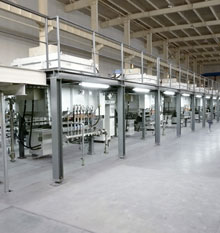It may have made another sort of mistake in solar energy
The company had a head start on technology that allows solar cells to be manufactured more cheaply, but lost out to Chinese competitors.
BP has had its share of missteps, including the worst oil spill in history. It may have made another sort of mistake in solar energy—failing to capitalize on an important advance that has now been taken up by Chinese solar-panel makers. The advance could help the Chinese companies maintain their overwhelming lead in the solar industry.
The technology is a new method for transforming chunks of raw silicon into large cubes of crystalline silicon. These large cubes can then be sliced into wafers to make solar cells. The new process results in monocrystalline silicon—which is needed for high-efficiency solar cells—at roughly half the cost of current methods. Most of the solar panels sold today use lower-quality multicrystalline silicon, which results in lower-power solar cells.
The new technology can be retrofitted to existing equipment, so factories that make multicrystalline solar cells could be quickly and cheaply upgraded to produce monocrystalline cells. The efficiency gains enabled by the technology could transform a 500-megawatt per year factory into a 540-megawatt factory (measured in the power output of the solar panels a factory produces).
The technology was originally developed and demonstrated on commercial-scale production equipment by BP in 2006, when it also announced its intention to put the technology into large-scale production. But BP never commercialized the technology. In the following three years, the company manufactured and installed thousands of solar panels using the technology for testing. Then, in March 2010, it closed its manufacturing operations, and development of the technology ground to a halt. BP later sold rights to the technology to the Dutch company AMG Advanced Metallurgical Group.
Meanwhile, a handful of Chinese solar-panel manufacturers, including Suntech, the world’s largest solar-cell manufacturer, have developed their own versions of the same process. Suntech started selling solar panels made using the process last summer.
“BP was very conservative,” says Roger Clark, chief operating officer at AMG IdealCast Solar, who was part of the research effort at BP Solar. “Even though they had publicized the technology at a trade show, they wanted to make sure that the wafers were stable.”
While BP carried out testing, some key details of the technology were becoming public knowledge. BP applied for a patent on the process, and, in 2007, the U.S. Patent Office published the patent applications. BP researchers also described aspects of the technology at conferences.
Clark worries that the “technology leaked out by diffusion.” He says, “I’m sure people started putting enough information together to be at least moderately successful in replicating the process elsewhere.”
Read more . . .
Bookmark this page for “solar innovation” and check back regularly as these articles update on a very frequent basis. The view is set to “news”. Try clicking on “video” and “2” for more articles.








